Look and Learn magazine.
The home of cutaway technical drawings of everything from hydroelectric dams to airplanes; the repository of one page synopses of the venerable classics of literature, opera, and ballet; and the sanctum of illustrated lessons in history and geography. The Discovery Channel before people had even thought of the Discovery Channel. In its dying days, it hosted Tony Weare’s comic Rookwood of which I remember very little. In its prime, it serialized the single most popular feature in the entire magazine—The Rise and Fall of the Trigan Empire.
[The Tower of Babel, Pieter Breugel the Elder]
No one outside the British Commonwealth is likely to have heard of The Trigan Empire. The Wikipedia page for Don Lawrence, the strip’s most revered artist, suggests that he was an influence on the likes of Brian Bolland, Dave Gibbons, and Chris Weston. Neil Gaiman had this to say about the comic some ten years back:
“When I was a boy, Don painted a comic I loved. It was called The Trigan Empire — two comics pages a week, in the otherwise comicsless and dryasdust children’s magazine “Look And Learn”, which even schools who banned comics allowed. It was the story of something a lot like an SF Roman Empire on a distant planet, and was gorgeous.”
There were other comics in Look and Learn of course. I distinctly remember that the stories from various ballets (like Giselle and Petrushka) were presented in the form of comics for example. However, there is no doubting that Mike Butterworth and Don Lawrence’s The Trigan Empire was the king of the heap—the solitary reason why kids forced their parents to buy Look and Learn week in week out. There were other artists who followed in Lawrence’s wake once he broke with IPC (the magazine distributors) over pay but he was the good Trigan artist just as Barks was the good duck artist. For these children, The Trigan Empire became an education in what comic books could look like, never once realizing that Lawrence’s work on the series was in fact a high point in British comic art, one which has been rarely equaled.
Here are the initial stirrings of The Trigan Empire as related on the second and third pages of its opening story (from the pages of Ranger magazine, its initial home).
A cosmo-craft crash lands in Florida and the documents retrieved from it are translated after decades of research. From the documents a history of the world of Elekton emerges and the history of the rise and fall of the Trigan Empire. The Trigans are descended from the Vorgs, a nomadic race compelled to choose the ways of civilization due to the encroachment of their perennial enemies, the Lokans.
Elekton was a world of wayward scientific evolution where individuals wore the armor and togas of the Roman empire while piloting modern day battleships, fighter jets, and rockets. The aircraft themselves would vary from vague facsimiles of Harrier jump jets (the British fighter elite of the day) to World War 2 heavy bombers fitted with jet engines—all this with little concern for the aerodynamic stability of this confluence of design. In many ways, the serial became a perfect reflection of the contents of the educational pamphlet enclosing it. One imagines that this mishmash of historical themes was created at least in part to fulfill an educational mission, to stimulate the curiosity of young children in the direction of the progress of European man.
The entirety of Don Lawrence’s work on The Trigan Empire has been reprinted in 12 slim hardcover volumes by the Don Lawrence Collection (under licence from DC Comics), an organization situated in the Netherlands, this being the nation which has best preserved the artist’s memory and much of his original art. The comics read seamlessly in episodes of varying length, with the reprintings often starting on a single facing page thus obscuring the 2-page a week format of the original strip. New readers will be oblivious to the fact that every two page segment actually ends with a cliffhanger. As an “old” reader, I was periodically lulled into this smooth experience.
Take for example, the 18 page story titled, “The Man from the Future” (1975), a tale which represents Lawrence’s return to the strip after a year long break. It is also the first Trigan Empire story I remember reading.
The story concerns a traveler from the future, an archivist who uses his intimate knowledge of the historical record for material gain and status. He arranges to buy a winning lottery ticket from its unsuspecting owner, “predicts” a Lokan attack thus inserting himself into the corridors of power, and then follows this up with a betrayal of the military plans of the Trigan political elite to the same Lokans. On every second page, the final panel shows (consecutively) the pride of the Trigan navy sinking, Toth Zandu’s profession to his young audience that he can look into the future, an attack on the Trigan Bay Bridge, two threats on Zandu’s life, the destruction of the Trigan fleet and so on – thus propelling the narrative onward with each passing week.
Zandu believes that he is invulnerable because the history books he has consulted have recorded his preservation to a ripe old age. The reader is constantly placed in a position of sympathy for Zandu as he escapes from each threat on his life before falling on the penultimate page in part due to his over confidence.
In a short but unrelated commentary, the editors for the Don Lawrence collection suggest that politics was rarely in the minds of The Trigan Empire‘s creators, the exception being the story titled, “The Mission of Lukaz Rann”, which takes in the subject of nuclear disarmament in the form of a planet killing bomb, and the practice of xenophobia in the guise of a demagogue based on the racist Member of Parliament, Enoch Powell.
There is some modest political correctness in this most British (post imperial) and conservative of comics. The dastardly Lokans who are colored green actually conform to no obvious race in many instances. They sometimes look like bearded Caucasians with a greenish hue and at other times like Africans or Asians (Indians?). Their one distinguishing trait is a perpetual state of irritation and fury, all knit brows and snarling teeth. A far cry then from their initial appearance in the first Trigan Empire tale where they seemed like refugees from Ming the Merciless’ army albeit with samurai headdress.
As for the barbarians at the gate, they were inevitably the Mongol hordes and vicious Native American “savages.” Maybe there were some Parthians thrown in for good measure but I don’t remember any. Just as the technology of the Trigans represented a patchwork of Western civilization and military dominance—from swords and sandals right up to weapons of mass destruction—so too did their enemies reflect the unchanging status of Western vulnerability as described by Joseph Schumpeter in “The Sociology of Imperialisms”:
“There was no corner of the known world where some interest was not alleged to be in danger or under actual attack. If the interests were not Roman, they were those of Rome’s allies….Rome was always being attacked by evil-minded neighbors, always fighting for a breathing-space. The whole world was pervaded by a host of enemies, and it was manifestly Rome’s duty to guard against their indubitably aggressive designs.”
The entire premise of the stories in The Trigan Empire was that they were transcribed from historical documents retrieved from a spacecraft. This would suggest a hagiographic record and, as Butterworth, intimates in “The Man from the Future,” outright lies. The Trigan hegemony triumphantly bringing peace and good will to the surrounding provinces and also ushering foreign nationals to its shores—this triumph of Western civilization resembling a fairy tale vision of the beneficent Pax Romana transferred to a semi-futuristic “Europe” bordered by barbarians and villains.
Consider more carefully the two pages shown above. The Lokan artillery divisions with their modern helmets are laying waste to a field of Trigan tanks (which look curiously like mutant combinations of a German Tiger and Panther tank) in a bravura display of destruction by Lawrence. Time and again throughout his tenure on the series, Lawrence would display his mastery of smoke, fire, and the implements of war.The retreating armies of the Trigans are not in the familiar bowl-shaped caps of the British infantry, nor the ceremonial galeas often seen on the heads of Trigo (the emperor) and his retinue. Instead, we find the equally familiar round helmets of the German army (the Nazis were of course enamored of all things Roman).
Perhaps the Nazis simply had the most attractive uniforms and the best looking tanks. The British made toy tanks I was given as a child included not only a suitably patriotic Saladin but also a German Tiger tank and a Jagdpanther. When you’re producing two water-colored pages (or more) every week for a children’s magazine, you can probably be forgiven for reaching for the coolest military ephemera at hand, particularly those which would be most attractive and recognizable to a young audience.
Yet it is hard to resist the suggestion here of an alternate history where the “civilizing” force of the Nazis has encompassed an entire continent producing a land of general tolerance, as well as law and order. A careful discussion of politics was beyond the remit of the series but the script clearly shows a subtle understanding of history out of keeping with its primary purpose as entertainment for under 10 year olds. A history where Churchill is both celebrated as a national hero and reviled as a man of unholy inclinations as demonstrated by his following statements:
“I am strongly in favour of using poisoned gas against uncivilised tribes. The moral effect should be so good that the loss of life should be reduced to a minimum. It is not necessary to use only the most deadly gasses: gasses can be used which cause great inconvenience and would spread a lively terror and yet would leave no serious permanent effects on most of those affected.” (12 May 1919)
“I want you to think very seriously over this question of poison gas… It is absurd to consider morality on this topic when everybody used it in the last war without a word of complaint from the moralists or the Church. On the other hand, in the last war bombing of open cities was regarded as forbidden. Now everybody does it as a matter of course. It is simply a question of fashion changing as she does between long and short skirts for women.” (6th July 1944)
When Toth Zandu’s deceit is finally discovered, Peric— the wisest man on Elekton, and clearly modeled on a stateless Greek—decides that history must be altered. But not only in order to deceive Zandu but to cover up their own foolishness:
In this sense, “The Man from the Future” affirms that history is not only written by the victors but also to preserve the dignity of the ruling class. If there was any semblance of tyranny or embarrassment in the record of the Trigan Empire, it has been systematically but ineffectively wiped out. For there is another unspoken question at the end of this tale. As I have mentioned, the comics which comprise The Trigan Empire are supposed to be histories in themselves. Who then wrote this “correct” history of Elekton and uncovered Peric’s deception?
Philip K. Dick’s The Man in the High Castle concerns just such a history where the Axis have triumphed and the “yanks” are now the “white barbarian Neanderthals.” Yet the reality of this physical apprehension is questioned by the book within a book, The Grasshopper Lies Heavy. The fake “antiques” peddled by another character, Frank Frink, are authenticated by mere pieces of paper as Wyndam-Matson (Frink’s employer) relates to an audience of one:
” ‘..a gun goes through a famous battle…and it’s the same as if it hadn’t, unless you know. It’s in here.’ He tapped his head. ‘In the mind, not the gun.’..[ ]…’I’d have to prove it to you with some sort of document. A paper of authenticity. And so it’s all a fake, a mass delusion. The paper proves its worth, not the object itself!'”
In melding the objects of war and civilization almost indiscriminately and in professing the wavering basis of the historical record, “The Man from the Future” partakes (if on a more elementary level) of this turmoil in historicity. For it calls into the question the entire beneficent record of the Trigans.
Like a scribe taking in the history of European man a millennium hence, it provides a panorama of Western civilization—the histories contiguous and undifferentiated by mere national boundaries. It relates a heroic and selective history of the Greeks and Romans but also communicates more subtly the devices of Fascism (and Hitler in particular); indulging simultaneously in the belief that all men are created equal while holding to disfiguring conceptions of everything without the borders of the empire—a surreptitious and perhaps unwitting interrogation of the basis of Western civilization from the perspective of a Boy’s Own adventure comic.
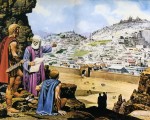
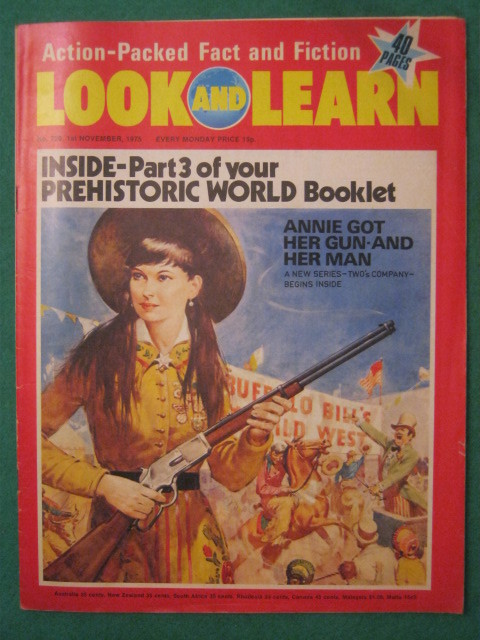
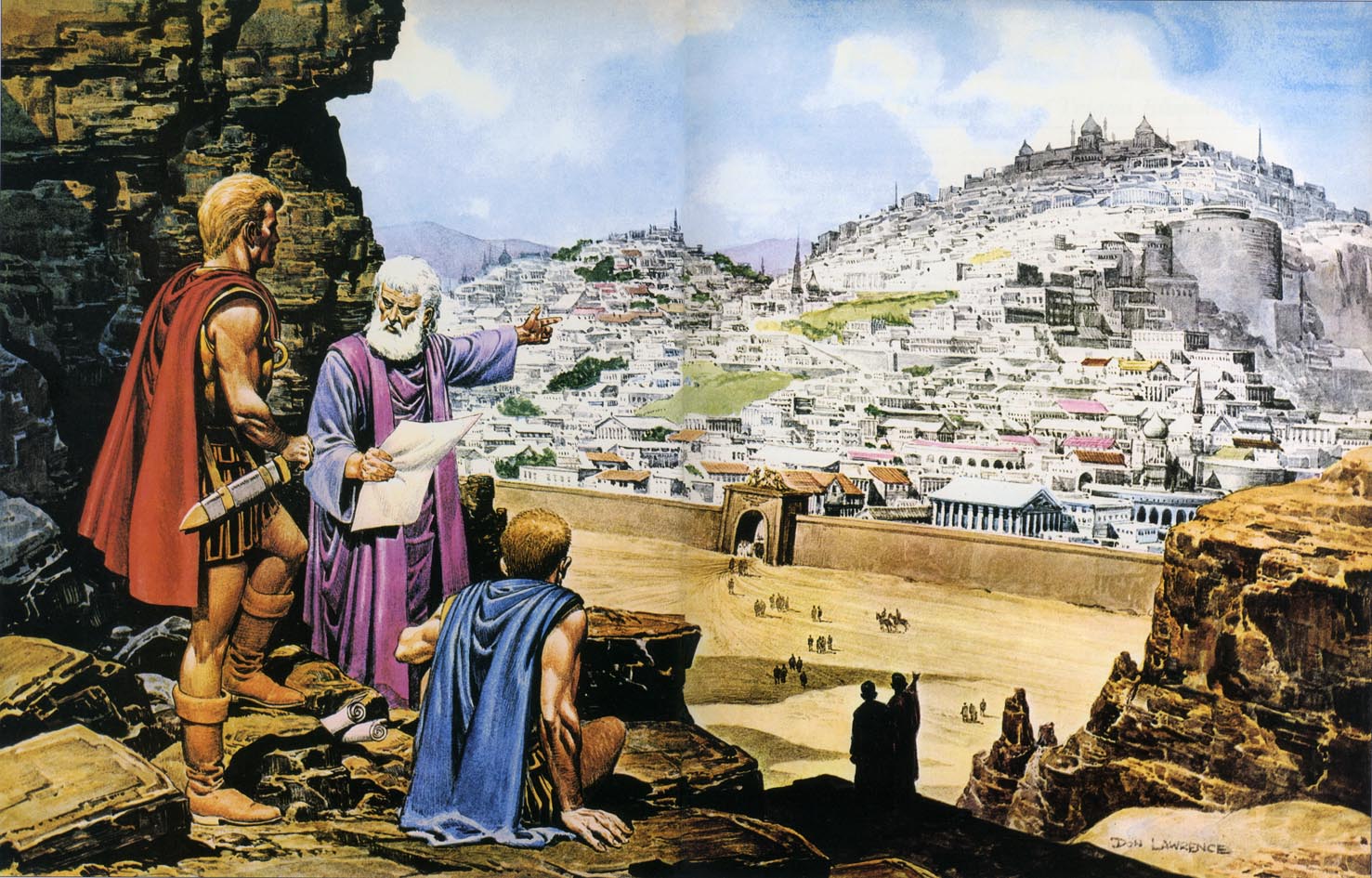
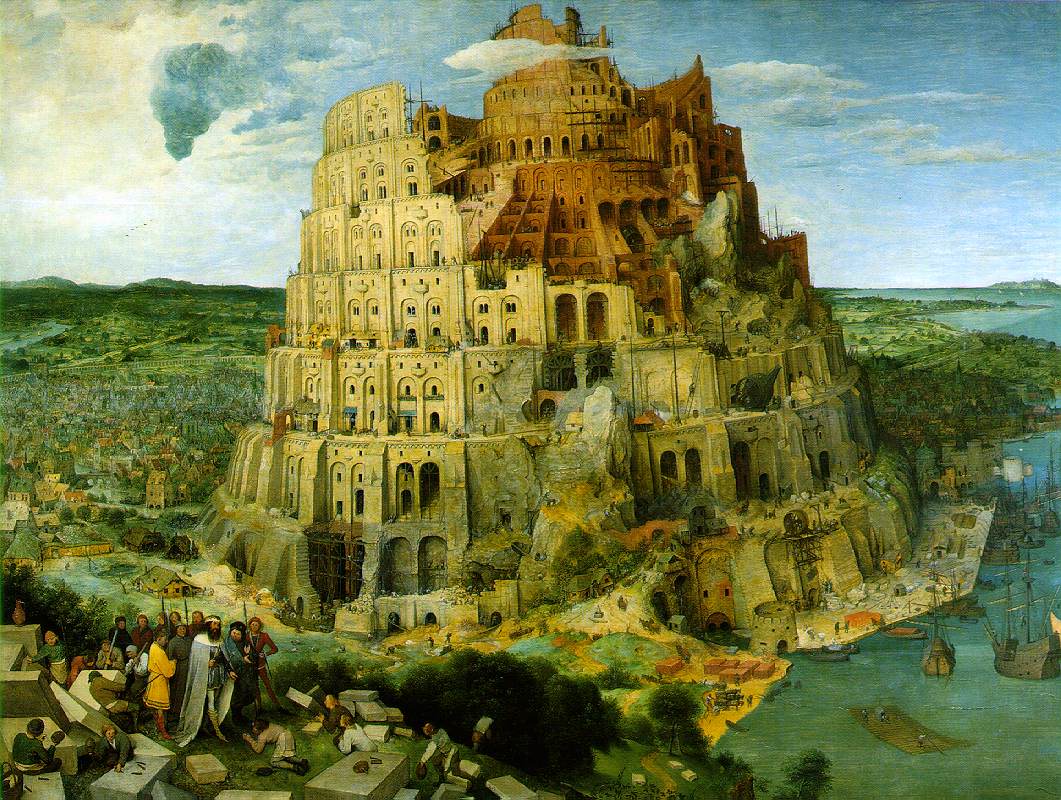
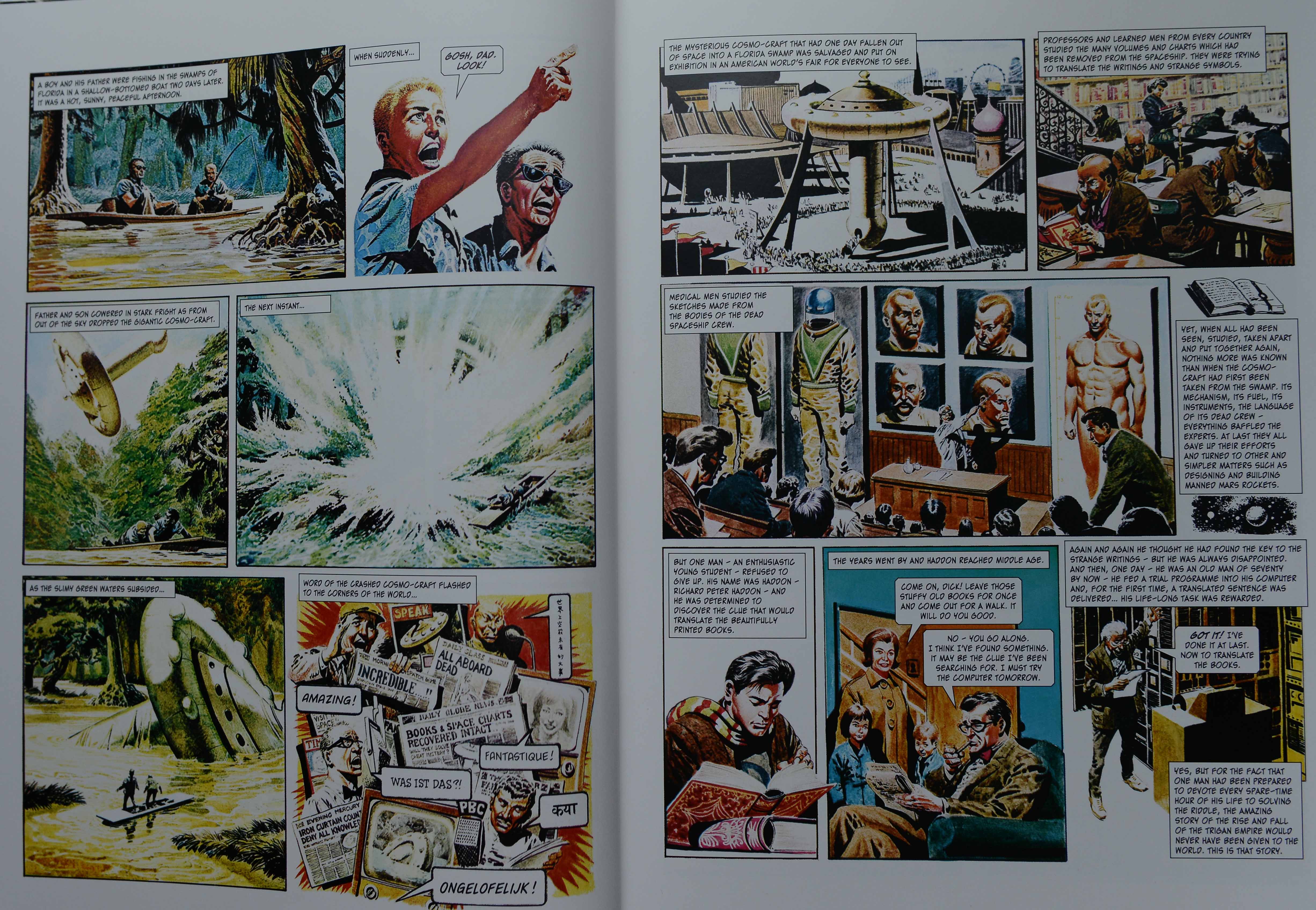
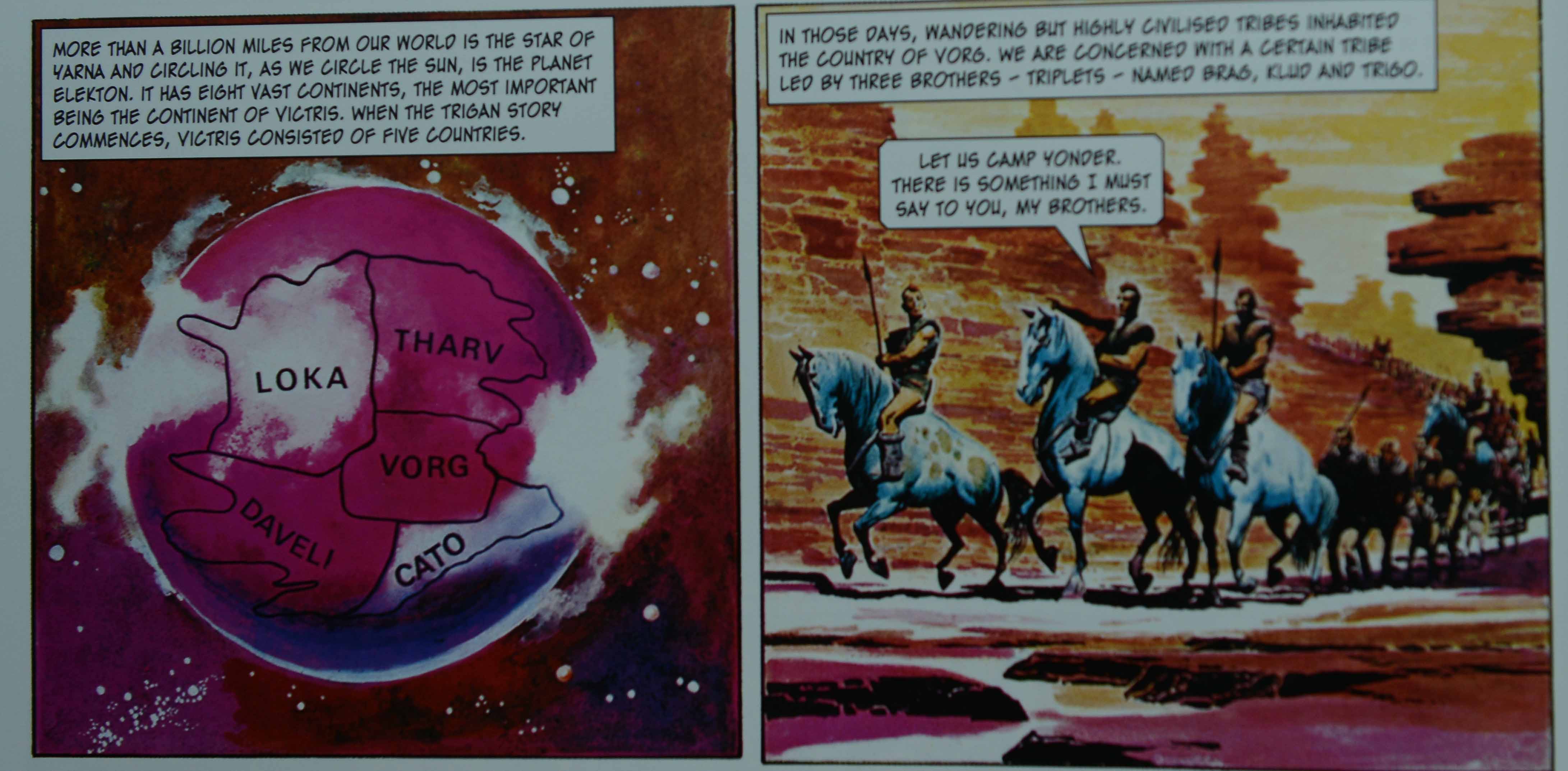
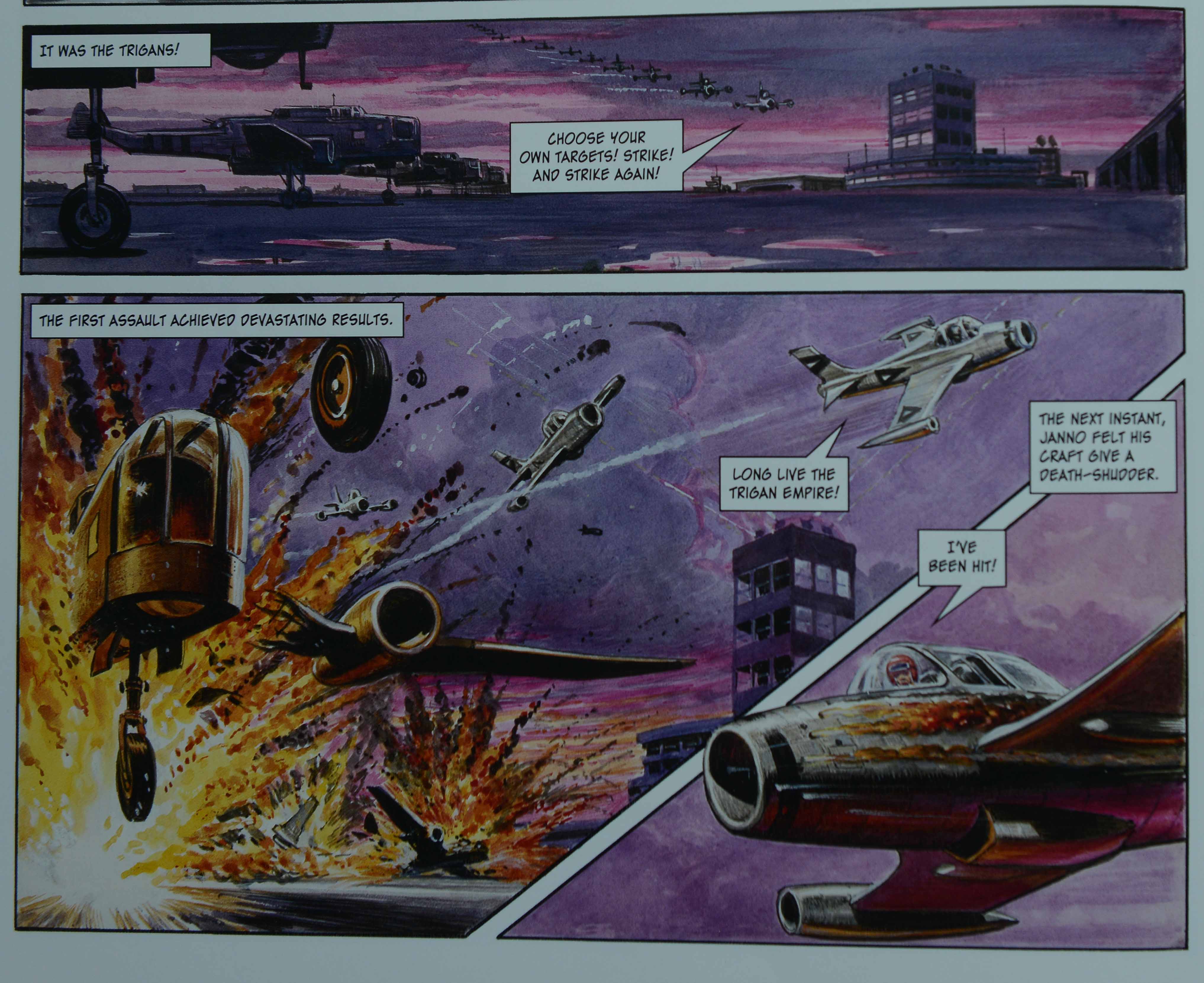
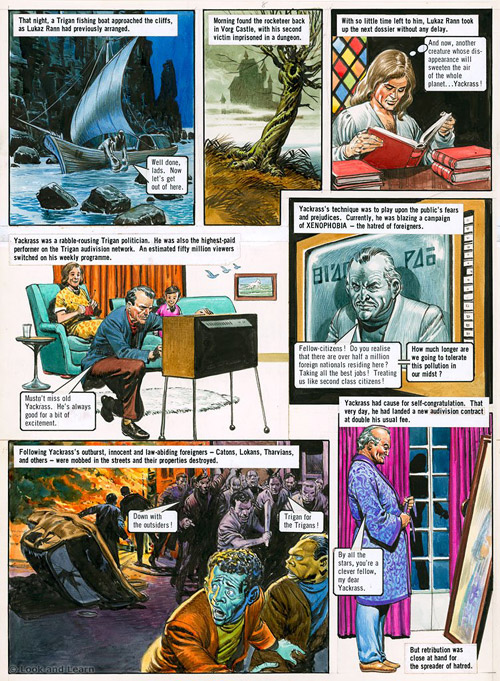
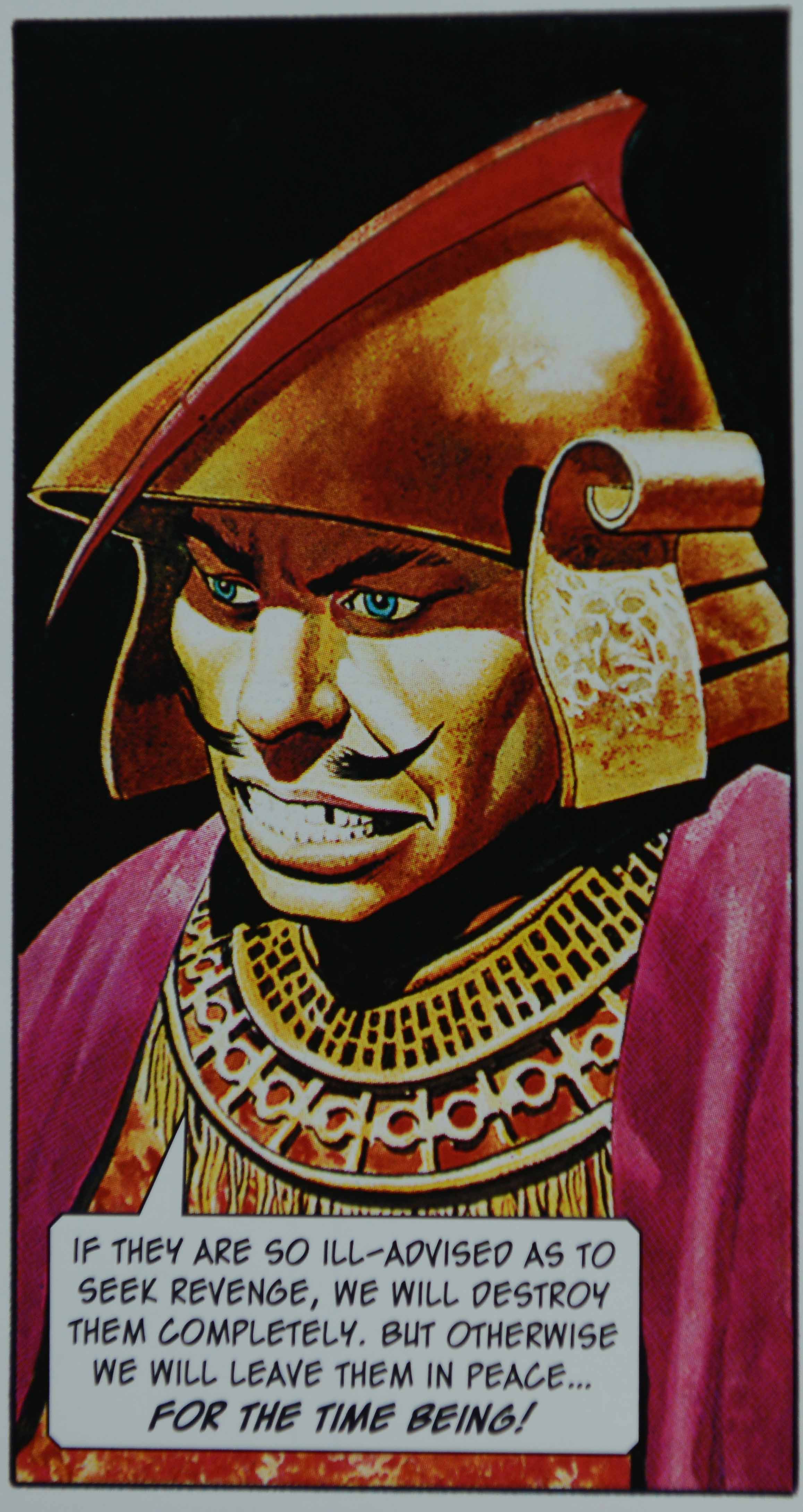
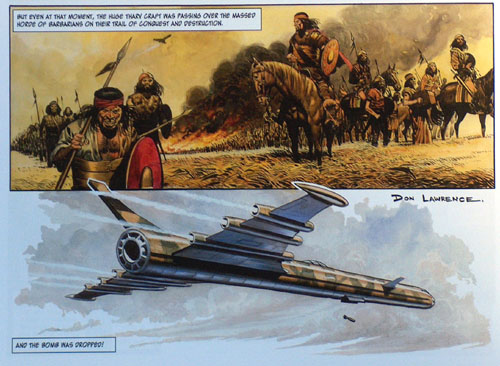
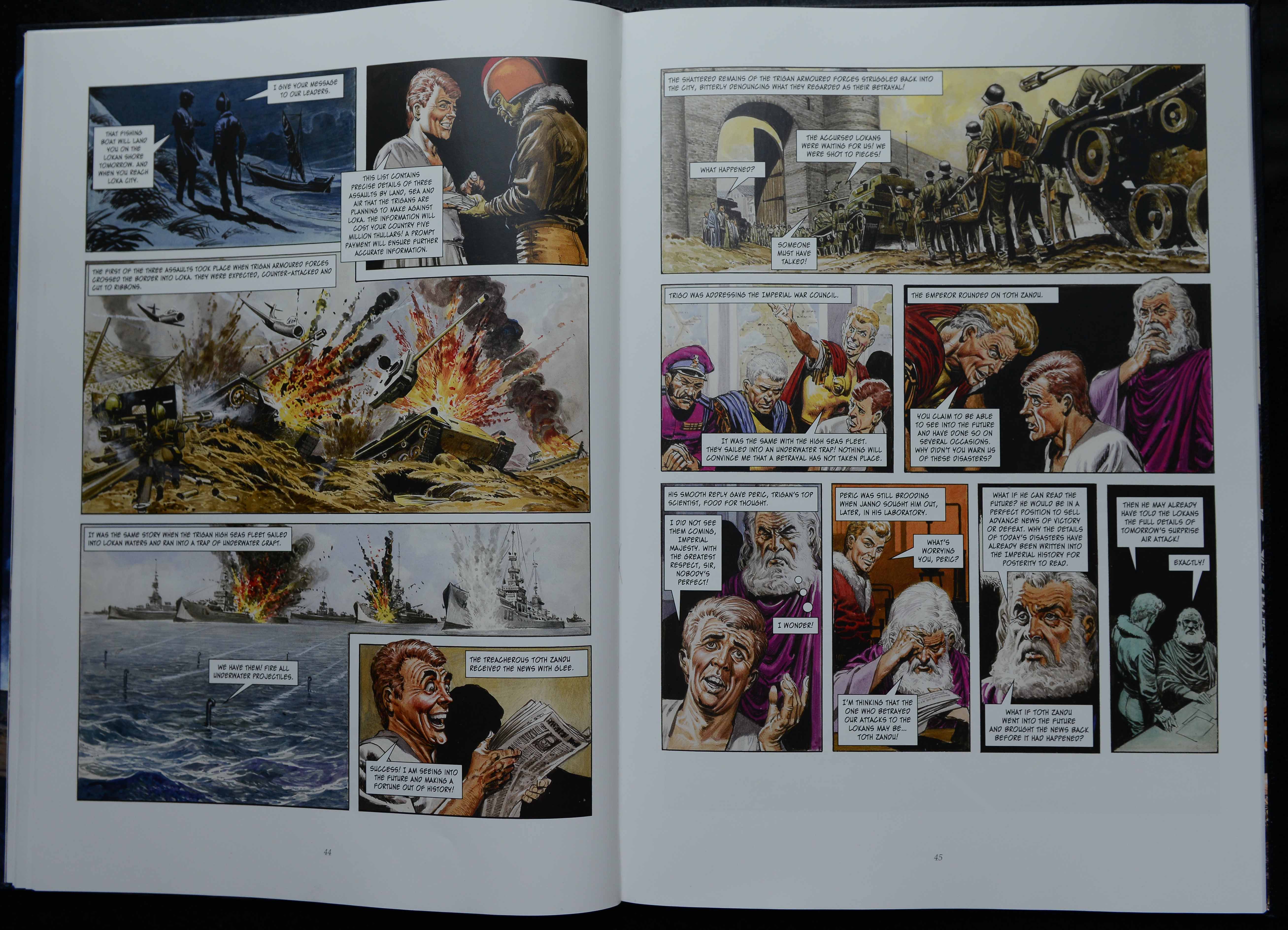
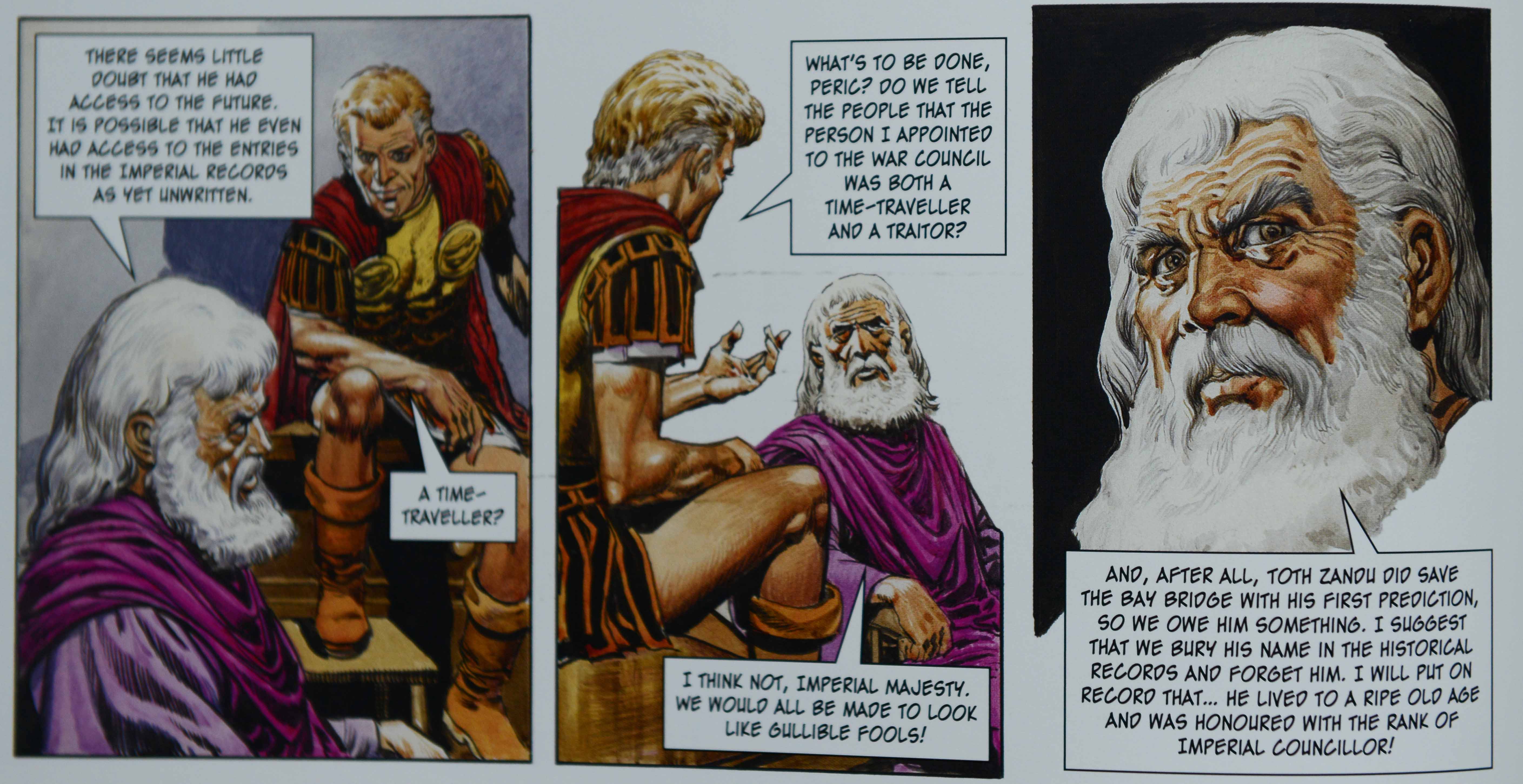
So is the Trigan Empire referencing Flash Gordon and other adventure strips explicitly then, do you think Suat? It sounds like you’re suggesting it’s close to Verhoeven’s Starship Troopers….
And didn’t Norman Spinrad write a book where the conceit was that Hitler had become a sci-fi writer? (The book was written as if by Hitler.) I don’t think I ever read that — has anyone else here?
It’s referencing Buck Rogers, Flash Gordon, Dane Dare etc. but it reads somewhat differently since it’s both an adventure story and a tale of empire building/upkeep. It also has much better cliffhangers in my view.
It’s impossible to tell how much in the story is intentional. But even if it was, it had to be done very subtly since this stuff is for elementary school kids. You don’t talk down the British empire in a kid’s educational mag – even in the 70s. Naturally, this might be a case of reading too much into the thing (cf. Dorfman and Mattelart’s How to Read Donald Duck). Old nostalgists love it mainly for the pretty pictures.
Of course, if you do things to subtly, you run the risk of getting accused of “collaborating.” As was the case with Zhang Yimou’s Hero when it was reviewed in the Western Press. Not realizing that the writer/director was comparing the Chinese Communist Party/Mao to the most notorious Emperor (an undisputed tyrant reviled by scholars) in Chinese history in that film.
Thanks for the article Suat. I’ve been dimly aware of this strip for ages, so it’s nice to get good a write-up.
Noah, Norman Spinrad’s book was called The Iron Dream. It’s very funny for the first 50 pages or so, but it’s essentially a one-joke novel and over the course of its length it gets a bit tiresome. The relationship between the hero, “Ferric Jaeger” and “Ludolf Best” is humorously handled as a kind of shy romance and there are endless descriptions of shiny, skin-tight uniforms and phallic weaponry. The introduction, describing the parallel universe Hitler’s career in the US pulp market as a noted illustrator/writer after his failed political career in Germany and the semi-scholarly analysis that follows are probably the best parts. (We learn for, for example, that the many of the uniforms and weapons described have become favorites among alternate universe cosplayers.) In addition to having a bit of PKD-ish fun Spinrad was also riffing to a certain extent on Lord of the Rings and Tolkien fandom. One amusing bit is that the tech level increases at an absurd rate: over a few months of novel time we go from WWII tech to interstellar starships.
A large hardbound Trigan Empire book was sold in American stores in the late 70s – early 1980s; a friend of mine had a copy and I envied it for years until I found one for myself. Later I bought a giant stack of ‘Look And Learn’ at an antique mall and was pleased to find Trigan Empire inside. Lovely strip.
Pingback: Comics A.M. | Investor group buys majority stake in Crunchyroll | Robot 6 @ Comic Book Resources – Covering Comic Book News and Entertainment
Pingback: The sun never sets on the Trigan Empire | Comic Book Report
None outside the Birtish Commonwealth apart from the Benelux of course, where the Trigan Empire and especially the Don Lawrence drawn parts of it were so popular a new series was created especially for him when it stopped.
Said series, Storm, is still running to this day, with a new spinoff series being launched that’s going to be written by Roy Thomas.
A common criticism of the series in the Netherlands btw was that the series was fascistic in its leanings, what with all the saluting and bowing and scraping before the emperor, who never failed but could only be failed.
I mention the Dutch above but I had no idea that Don Lawrence was a big thing in Belgium much less Luxembourg. I’ve read some less than happy things said about the non-Don Lawrence Storms.
Thanks for the write up. As a kid in rural Australia I looked forward to my Look and Learn magazines more than anything, and especially the Trigan Empire, one of the greatest and largely unsung comics of all time.
I had the very good fortune to speak with both Mike Butterworth and meet Don Lawrence during the early eighties, in anticipation of writing an article about the Trigan Empire.
Without a doubt this strip is a piece of British history up there with the TV programmes of Gerry Anderson – fondly remembered by a whole generation.
I have read the above article with interest and thought it excellent but let me throw in a couple of interesting considerations:
Mike Butterworth was a leading member of the “Sealed Knot” English civil war re-enactment group and a staunch royalist to boot. He believed firmly in royalty and the rights of the imperilalists. He was also a man who enjoyed “catch penny titles as well as adapting some of his own work (The man who broke the Bank at Monte Carlo).to good effect. That said, there can be no question that the Trigan Empire represents a beneficient dictatorship but this does not detract from the sheer grandeur or majesty of this fantastic strip.
Thanks for the information! Butterworth as a royalists does make perfect sense.
Comic critic Horst Schröder did an analysis of Trigan Empire in his book “Framtiden i serierutor” (“The future in comic strip panels”) from 1981. The four page chapter is extremely critical of the work, mainly because of its political message. “[… it] embodies the worst reactionary traits of the worst science fiction.”
As a child I would await the purchase of that weeks “Look And Learn” most impatiently. Being the youngest I would sometimes have to wait to read it but anticipation and joy of that moment when I had it in my hands stays with me today. I would force myself to read the articles and stories (the geek in me enjoyed them, anyway – I’m now an engineer!) but the reward was to read that weeks instalment of ‘The Trigan Empire’. I loved it, and it’s probably what has instilled a life long love of science fiction. The politics and messages within the stories didn’t interest me then and only mildly pique it now. They were on the whole good stories and when you are 7 years old that all you care about. Astonishingly the full set is available as a 12 volume set of hardbooks. BUT the price!!! Maybe they’ll re-release them.
Yes, they’re quite expensive and have to be shipped all the way from Holland but they’re quite beautiful books with lots of behind the scenes information in them. Reproductions are on the whole excellent. It’s being released by a small firm which also sells some of Lawrence’s original art so I don’t think there’s much chance that it will get a large scale popular release. 2000AD it’s not! Also, and this may be important to you, the books don’t contain non-Lawrence material.
I’ve just bought a swag of Look and Learns on Ebay, to recover the supply that was stolen many years ago. Ohhh, the Trigan Empire! How it fired my imagination! As a teenager, I was desperately in love with Emperor Trigo- so intelligent and handsome, but I had sympathy for his dim-witted, well- meaning brother, Brag. The artwork was so brilliant that it effortlessly immersed me in the “reality” of this planet and the lives of its denizens. I loved every part of Look and Learn, but once it started featuring the Trigan Empire, well, that truly was gilding the lily!
But, but, but…what about poor Janno? It’s sort of interesting that Lawrence who went on to draw “Storm” wasn’t terribly interested in drawing the kind of “sexy” women now typical of superhero comics. In fact, I do believe there was a tremendous amount of beefcake in those comics – could be the Aryan ideal…
And what kind of person steals copies of Look and Learn!
When I met with Don Lawrence he admitted to a love of drawing “sexy females” and was clearly keen on nudes. However, whilst he did illustrate “Carrie” for Mayfair magazine he balked at his successor who made the strip vulgar in it portrayal of sex and the female body. My guess is there was very little call for sexy women in the Trigan Empire, particularly as it appeared to be a patriarchal society with no leading ladies beyond Peric’s daughter, Salvia.
Or maybe it was simply a function of its mode of release – in Look and Learn magazine which might have had a puritan aesthetic. Or could it have been down to Mike Butterworth. Everyone else in the adventure strip tradition seemed to make time for scantily clad women.
On the other hand, they never missed an excuse to have their leading men strip off their tops and show off their toned torsos.
Ng, many thanks for this item on The Trigan Empire–it really took me back! I loved it when I read it in elementary school at the age of ten or eleven or so. It had a great impact on me, not just the adventure but some of the cosmic elements–time travel, etc.–which probably had a lot to do with my love of science fiction which I developed a little later.
Regarding the end of your article, I may be misunderstanding something, but it seems to me that the contradiction between espousing beliefs in human equality, and empire-building, is more typical of “mainstream” Western imperialism (whether under the Romans or the British more recently) than fascism or Nazism. The fascists never pretended to believe in human equality–their racism and elitism was much more open.
Thanks for the comment, Carl. That last paragraph was more like a summary of the various elements that make up the adult Trigan experience. The imperialism is naturally at the forefront as well as the sense of divine purpose and anointment. But there is also scattered throughout the trappings of fascism which is why some arch liberals would label the United States both imperialistic and fascist (while paying lip service to egalitarianism).
AS Ng Suat Tong indicates above, The Trigan Empire was appearing in what was essentially a middle-class educational mangazine mostly aimed at boys. According to Butterworth the whole strip was based on the simple premise that Romans and Spaceships were in vogue at the time. Hardly surprising, therefore, that there is a dirth of scantily-clad women However, I stick with others in saying that this benevolent dictatorship always appeared to be an attractive world to me and no other comic strip has come near creating a world that was so fantastical bnut also enevloping.
Ng, thanks for uploading this. Trigan Empire was my favourite comic strip when I was in primary school (between the age of 10 to 12) living in KL, Malaysia. Brings back fond memories.
Don Lawrence ranks for me as one of the great geniuses of comic art. The Don Lawrence Collection did a superb job of republishing the Trigan Empire and Storm series.
@Nariman Dubash: The editorial chapter of Book 9 (Storm The Collection) mentions the visits of Mr Doubal Dubash to Don Lawrence’s studio and the pictures he took of Don Lawrence at work. Non of these pictures have ever been published, so it seems. Would it be possible to have a copy of these pictures and the interview materials? I am writing an article on Don Lawrence, and your help would be most helpful and appreciated. Please contact me at johan.buylen (at) gmail.com Many thanks in advance!
Pingback: The Trigan Empire | The Cedar Lounge Revolution
“No one outside the British Commonwealth is likely to have heard of The Trigan Empire.”
In addition to the Benelux which was pointed out, I’d like to mention that Storm and Trigan Empire were popular in Indonesia.
Many Dutch comics were popular in Indonesia – Storm was first serialised in the Indonesian translation of the popular Dutch comic magazine Eppo.